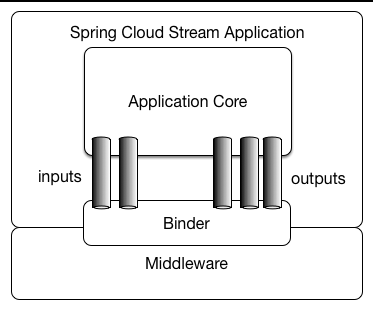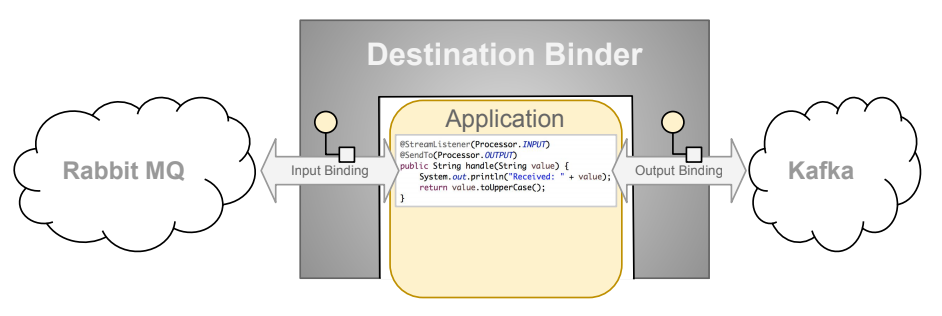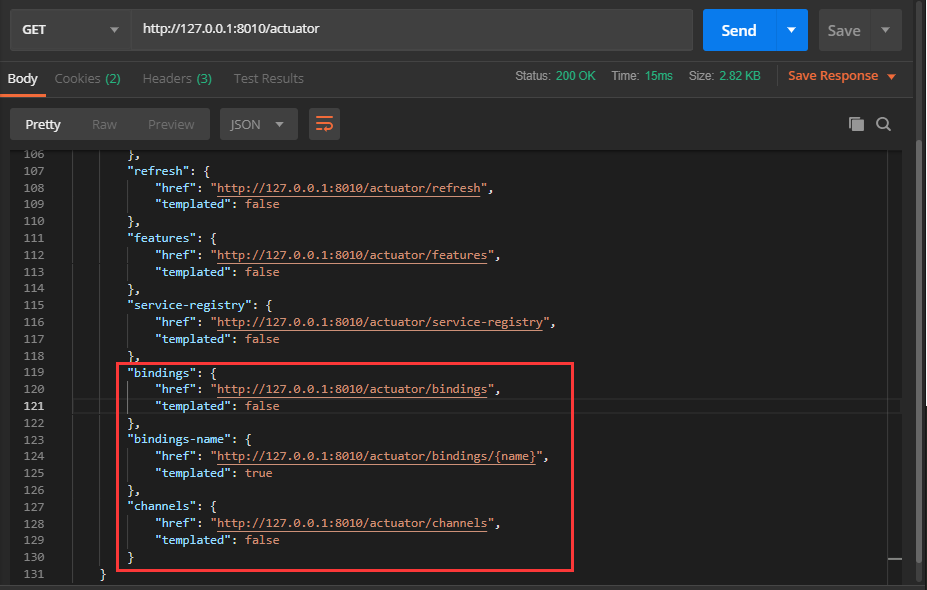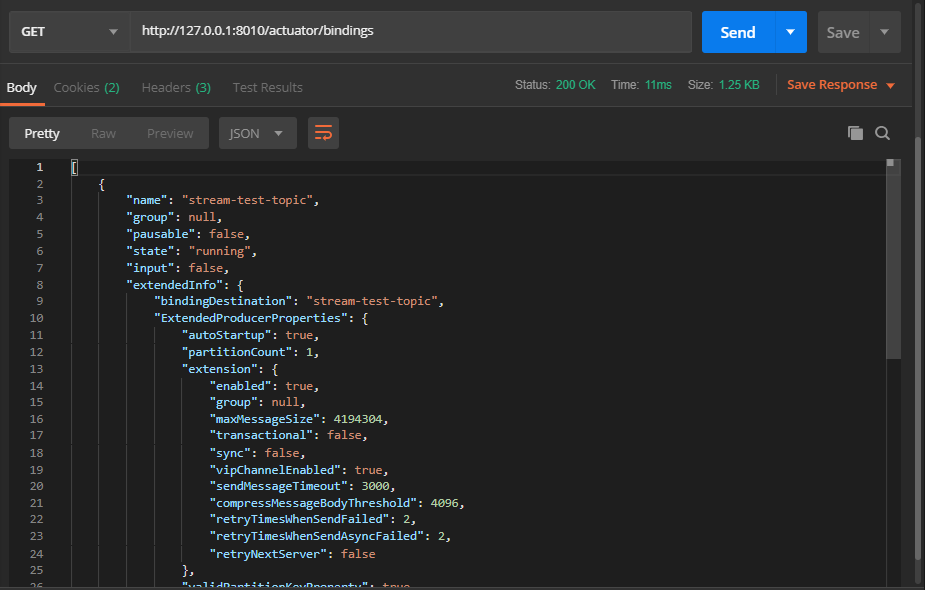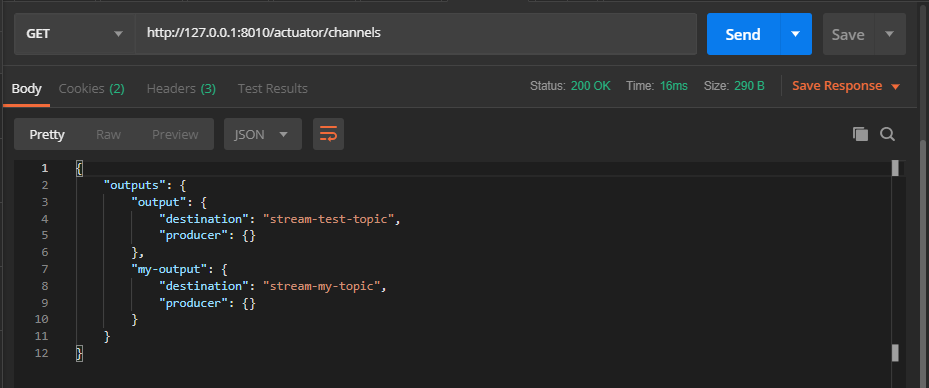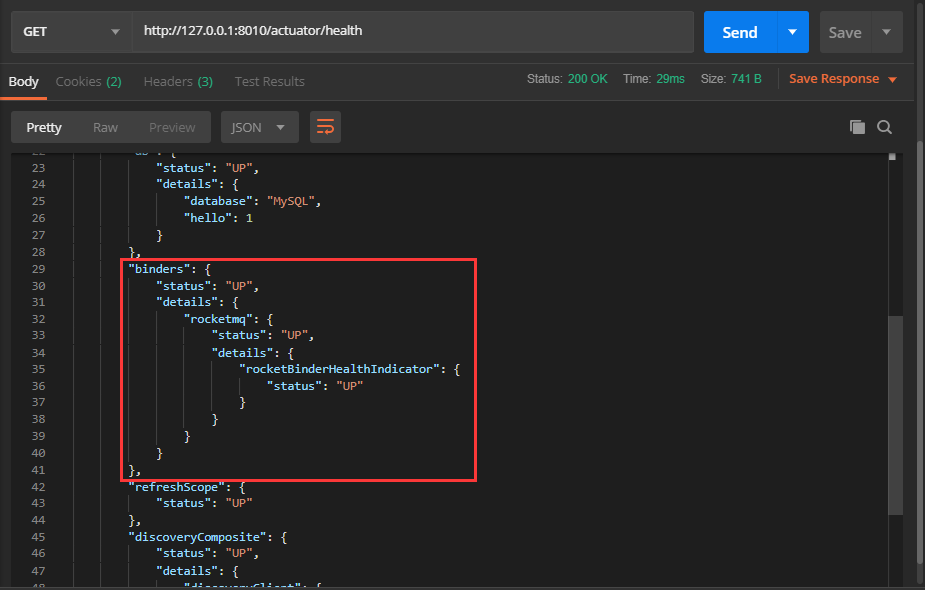Spring Cloud Stream簡介
Spring Cloud Stream是什麼:
Spring Cloud Stream是Spring Cloud的一個子項目,是一個能讓我們更加方便操作MQ的框架,其目的用於構建與消息中間件連接的高度可伸縮的消息事件驅動的微服務
簡單來說Spring Cloud Stream就是一個簡化了MQ操作的框架,其架構圖如下:
- 圖片來自官方文檔,從圖中可以看到應用通過input和output與Binder進行交互,而Binder是一個讓我們的微服務與MQ集成的組件。圖中的Middleware即是消息中間件,目前支持Kafka、RabbitMQ以及RocketMQ
Spring Cloud Stream編程模型:
- 圖片來自官方文檔,微服務(Application)集成了Stream後,Stream的Destination Binder會創建兩個Binding,左邊的Binding連接着RabbitMQ,右邊的Binding連接着Kafka。左邊的Binding從RabbitMQ消費消息,然後經過圖中代碼的處理後,把處理結果通過右邊的Binding投遞到Kafka。簡單來說,就是這個微服務消費了RabbitMQ裏的消息並對其進行處理,最後將處理的結果投遞到Kafka中。Input和Output是消息相對與微服務的走向,input表示微服務接收消息,output表示微服務投遞消息或發送消息
關於圖中的概念:
- Destination Binder(目標綁定器):與消息中間件通信的組件,用於實現消息的消費和投遞
- Destination Bindings(目標綁定):Binding是連接應用程序跟消息中間件的橋樑,用於消息的消費和生產,由binder創建
使用Spring Cloud Stream
現在有一個微服務項目:content-center,該微服務作爲生產者,我們來爲這個微服務集成Spring Cloud Stream,第一步添加stream依賴:
<dependency>
<groupId>com.alibaba.cloud</groupId>
<artifactId>spring-cloud-starter-stream-rocketmq</artifactId>
</dependency>- Tips:該項目的Spring Cloud版本爲:Greenwich.SR1;Spring Cloud Alibaba版本爲:2.1.0.RELEASE
第二步,在啓動類上添加@EnableBinding註解,如下:
import org.springframework.cloud.stream.annotation.EnableBinding;
import org.springframework.cloud.stream.messaging.Source;
@EnableBinding(Source.class)
...第三步,在配置文件中,添加與stream相關的配置項:
spring:
cloud:
stream:
rocketmq:
binder:
name-server: 192.168.190.129:9876
bindings:
# 生產者爲output
output:
# 用於指定topic
destination: stream-test-topic完成以上步驟後,項目就已經集成了Spring Cloud Stream,現在我們來使用Spring Cloud Stream編寫生產者,具體代碼如下:
package com.zj.node.contentcenter.controller.content;
import lombok.RequiredArgsConstructor;
import org.springframework.cloud.stream.messaging.Source;
import org.springframework.messaging.Message;
import org.springframework.messaging.support.MessageBuilder;
import org.springframework.web.bind.annotation.GetMapping;
import org.springframework.web.bind.annotation.RestController;
/**
* 生產者
*
* @author 01
* @date 2019-08-10
**/
@RestController
@RequiredArgsConstructor
public class TestProducerController {
private final Source source;
@GetMapping("/test-stream")
public String testStream(){
Message<String> message = MessageBuilder
.withPayload("消息體")
.build();
source.output()
.send(message);
return "send message success!";
}
}啓動項目,測試該接口是否能成功執行:
然後爲另一個作爲消費者的微服務項目:user-center,集成Spring Cloud Stream,由於依賴配置是一樣的,這裏就不進行重複了,但是配置和註解裏的類需要更改一下。首先是配置如下:
spring:
cloud:
stream:
rocketmq:
binder:
name-server: 192.168.190.129:9876
bindings:
# 消費者爲input
input:
# 用於指定topic
destination: stream-test-topic
# rocketmq必須配置group,否則啓動會報錯
# 如果使用的是其他MQ,則不是必須配置的
group: binder-group啓動類的註解如下:
import org.springframework.cloud.stream.annotation.EnableBinding;
import org.springframework.cloud.stream.messaging.Sink;
@EnableBinding(Sink.class)
...完成集成後,使用Spring Cloud Stream編寫消費者,具體代碼如下:
package com.zj.node.usercenter.rocketmq;
import lombok.extern.slf4j.Slf4j;
import org.springframework.cloud.stream.annotation.StreamListener;
import org.springframework.cloud.stream.messaging.Sink;
import org.springframework.stereotype.Service;
/**
* 消費者
*
* @author 01
* @date 2019-08-10
**/
@Slf4j
@Service
public class TestStreamConsumer {
@StreamListener(Sink.INPUT)
public void receive(String messageBody) {
log.info("通過stream收到了消息,messageBody = {}", messageBody);
}
}完成代碼的編寫後啓動項目,由於先前我們已經通過生產者往RocketMQ投遞了消息,所以此時控制檯會輸出接收到的消息,如下:
Spring Cloud Stream自定義接口
通過以上小節的學習,我們已經瞭解了Spring Cloud Stream的基本使用。從以上示例可以得知,input用於綁定一個topic消費消息,output則反之,用於綁定一個topic投遞消息。
但在實際的項目中,可能會有多個topic,甚至在極端場景下,不同的topic可能使用不同的MQ實現,而stream默認提供的input和output都只能綁定一個topic,所以這個時候就需要用到stream的自定義接口來實現多個“input”和“output”綁定不同的topic了。
在以上小節的示例中可以得知,生產者發送消息時使用的是Source接口裏的output方法,而消費者發送消息時使用的是Sink接口裏的input方法,並且都需要配置到啓動類的@EnableBinding註解裏。所以實際上我們需要自定義接口的源碼與這兩個接口的源碼幾乎一致,只是名稱有所不同而已,使用上也只是將Source和Sink改爲自定義的接口即可。
接下來簡單演示一下如何自定義接口並使用,我們基於上一小節的例子進行改造。首先是生產者,定義一個用於發送消息的接口,具體代碼如下:
package com.zj.node.contentcenter.rocketmq;
import org.springframework.cloud.stream.annotation.Output;
import org.springframework.messaging.MessageChannel;
/**
* 自定義發送消息接口,與stream默認提供的Source源碼是類似的
*
* @author 01
* @date 2019-08-10
**/
public interface MySource {
/**
* Name of the output channel.
*/
String MY_OUTPUT = "my-output";
/**
* @return output channel
*/
@Output(MY_OUTPUT)
MessageChannel output();
}然後在啓動類的@EnableBinding中,添加這個接口:
import org.springframework.cloud.stream.annotation.EnableBinding;
import org.springframework.cloud.stream.messaging.Source;
@EnableBinding({Source.class, MySource.class})
...在配置文件中添加如下配置:
spring:
cloud:
stream:
rocketmq:
binder:
name-server: 192.168.190.129:9876
bindings:
# 生產者爲output
output:
# 用於指定topic
destination: stream-test-topic
# 自定義的”output“,這裏的名稱需要與MySource接口裏的MY_OUTPUT相對應
my-output:
# 綁定不同的topic
destination: stream-my-topic 修改生產者的代碼如下即可:
package com.zj.node.contentcenter.controller.content;
import com.zj.node.contentcenter.rocketmq.MySource;
import lombok.RequiredArgsConstructor;
import org.springframework.messaging.Message;
import org.springframework.messaging.support.MessageBuilder;
import org.springframework.web.bind.annotation.GetMapping;
import org.springframework.web.bind.annotation.RestController;
/**
* 生產者
*
* @author 01
* @date 2019-08-03
**/
@RestController
@RequiredArgsConstructor
public class TestProducerController {
private final MySource mySource;
@GetMapping("/test-stream")
public String testStream(){
Message<String> message = MessageBuilder
.withPayload("消息體")
.build();
mySource.output()
.send(message);
return "send message success!";
}
}然後啓動項目訪問該接口,測試消息是否能正常發送:
改造完生產者後接着改造消費者,首先定義一個用於消費消息的接口,具體代碼如下:
package com.zj.node.usercenter.rocketmq;
import org.springframework.cloud.stream.annotation.Input;
import org.springframework.messaging.SubscribableChannel;
/**
* 自定義消費消息接口,與stream默認提供的Sink源碼是類似的
*
* @author 01
* @date 2019-08-10
**/
public interface MySink {
/**
* Input channel name.
*/
String MY_INPUT = "my-input";
/**
* @return input channel.
*/
@Input(MY_INPUT)
SubscribableChannel input();
}同樣需要在啓動類的@EnableBinding中,添加這個接口:
import org.springframework.cloud.stream.annotation.EnableBinding;
import org.springframework.cloud.stream.messaging.Sink;
@EnableBinding({Sink.class, MySink.class})
...在配置文件中添加如下配置:
spring:
cloud:
stream:
rocketmq:
binder:
name-server: 192.168.190.129:9876
bindings:
# 消費者爲input
input:
# 用於指定topic
destination: stream-test-topic
# rocketmq必須配置group,否則啓動會報錯
# 如果使用的是其他MQ,則不是必須配置的
group: binder-group
# 自定義的”input“,這裏的名稱需要與MySink接口裏的MY_INPUT相對應
my-input:
# 綁定不同的topic
destination: stream-my-topic
group: my-group修改消費者的代碼如下:
package com.zj.node.usercenter.rocketmq;
import lombok.extern.slf4j.Slf4j;
import org.springframework.cloud.stream.annotation.StreamListener;
import org.springframework.stereotype.Service;
/**
* 消費者
*
* @author 01
* @date 2019-08-10
**/
@Slf4j
@Service
public class TestStreamConsumer {
@StreamListener(MySink.MY_INPUT)
public void receive(String messageBody) {
log.info("自定義接口 - 通過stream收到了消息,messageBody = {}", messageBody);
}
}啓動項目,由於先前我們已經通過生產者往RocketMQ投遞了消息,所以此時控制檯會輸出接收到的消息,如下:
Spring Cloud Stream的監控
我們都知道Spring Boot Actuator組件用於暴露監控端點,很多監控工具都需要依賴該組件的監控端點實現監控。而項目集成了Stream及Actuator後也會暴露相應的監控端點,首先需要在項目裏集成Actuator,添加依賴如下:
<!-- actuator -->
<dependency>
<groupId>org.springframework.boot</groupId>
<artifactId>spring-boot-starter-actuator</artifactId>
</dependency>在配置文件中添加如下配置:
management:
endpoints:
web:
exposure:
# 暴露所有監控端點
include: '*'
endpoint:
health:
# 顯示健康檢測詳情
show-details: always訪問http://127.0.0.1:{項目端口}/actuator可以獲取所有暴露出來的監控端點,Stream的相關監控端點也在其列,如下圖:
/actuator/bindings端點可以用於查看bindings相關信息:
/actuator/channels端點用於查看channels的相關信息,而“input”和“output”就是所謂的channel,可以認爲這些channel是topic的抽象:
在/actuator/health端點中可以查看binder及RocketMQ的狀態,主要是用於查看MQ的連接情況,如果連接不上其status則爲DOWN:
Spring Cloud Stream + RocketMQ實現事務消息
先前在Spring Cloud Alibaba RocketMQ - 構建異步通信的微服務一文的末尾中,我們介紹了RocketMQ的事務消息並且也演示瞭如何編碼實現。在本文學習了Spring Cloud Stream之後,我們來結合Stream對之前實現事務消息的代碼進行重構。
首先修改配置文件如下:
spring:
cloud:
stream:
rocketmq:
binder:
name-server: 192.168.190.129:9876
bindings:
output:
producer:
# 開啓事務消息,這樣通過output這個channel發送的消息都是半消息
transactional: true
# 生產者所在的事務組名稱
group: tx-test-producer-group
bindings:
# 生產者爲output
output:
# 用於指定topic
destination: stream-test-topic然後重構TestProducerService,具體代碼如下:
package com.zj.node.contentcenter.service.test;
import com.alibaba.fastjson.JSON;
import com.zj.node.contentcenter.dao.content.NoticeMapper;
import com.zj.node.contentcenter.dao.log.RocketmqTransactionLogMapper;
import com.zj.node.contentcenter.domain.entity.content.Notice;
import com.zj.node.contentcenter.domain.entity.log.RocketmqTransactionLog;
import lombok.RequiredArgsConstructor;
import org.apache.rocketmq.spring.support.RocketMQHeaders;
import org.springframework.cloud.stream.messaging.Source;
import org.springframework.messaging.support.MessageBuilder;
import org.springframework.stereotype.Service;
import org.springframework.transaction.annotation.Transactional;
import java.util.UUID;
/**
* @author 01
* @date 2019-08-08
**/
@Service
@RequiredArgsConstructor
public class TestProducerService {
private final NoticeMapper noticeMapper;
private final RocketmqTransactionLogMapper rocketmqTransactionLogMapper;
private final Source source;
public String testSendMsg(Notice notice) {
// 生成事務id
String transactionId = UUID.randomUUID().toString();
// 通過stream發送消息,這裏實際發送的就是半消息
source.output().send(
MessageBuilder.withPayload("消息體")
// header是消息的頭部分,可以用作傳參
.setHeader(RocketMQHeaders.TRANSACTION_ID, transactionId)
.setHeader("notice_id", notice.getId())
// 對象需要轉換成json,否則默認是調用對象的toString方法轉換爲字符串
.setHeader("notice", JSON.toJSONString(notice))
.build()
);
return "send message success";
}
@Transactional(rollbackFor = Exception.class)
public void updateNotice(Integer noticeId, Notice notice) {
Notice newNotice = new Notice();
newNotice.setId(noticeId);
newNotice.setContent(notice.getContent());
noticeMapper.updateByPrimaryKeySelective(newNotice);
}
@Transactional(rollbackFor = Exception.class)
public void updateNoticeWithRocketMQLog(Integer noticeId, Notice notice, String transactionId) {
updateNotice(noticeId, notice);
// 寫入事務日誌
rocketmqTransactionLogMapper.insertSelective(
RocketmqTransactionLog.builder()
.transactionId(transactionId)
.log("updateNotice")
.build()
);
}
}最後是重構TestTransactionListener,具體代碼如下:
package com.zj.node.contentcenter.rocketmq;
import com.alibaba.fastjson.JSON;
import com.zj.node.contentcenter.dao.log.RocketmqTransactionLogMapper;
import com.zj.node.contentcenter.domain.entity.content.Notice;
import com.zj.node.contentcenter.domain.entity.log.RocketmqTransactionLog;
import com.zj.node.contentcenter.service.test.TestProducerService;
import lombok.RequiredArgsConstructor;
import lombok.extern.slf4j.Slf4j;
import org.apache.rocketmq.spring.annotation.RocketMQTransactionListener;
import org.apache.rocketmq.spring.core.RocketMQLocalTransactionListener;
import org.apache.rocketmq.spring.core.RocketMQLocalTransactionState;
import org.apache.rocketmq.spring.support.RocketMQHeaders;
import org.springframework.messaging.Message;
import org.springframework.messaging.MessageHeaders;
/**
* 本地事務監聽器
*
* @author 01
* @date 2019-08-08
**/
@Slf4j
@RequiredArgsConstructor
// 這裏的txProducerGroup需要與配置文件裏配置的一致
@RocketMQTransactionListener(txProducerGroup = "tx-test-producer-group")
public class TestTransactionListener implements RocketMQLocalTransactionListener {
private final TestProducerService service;
private final RocketmqTransactionLogMapper rocketmqTransactionLogMapper;
/**
* 用於執行本地事務的方法
*/
@Override
public RocketMQLocalTransactionState executeLocalTransaction(Message msg, Object arg) {
MessageHeaders headers = msg.getHeaders();
String transactionId = (String) headers.get(RocketMQHeaders.TRANSACTION_ID);
log.info("執行本地事務方法. 事務id: {}", transactionId);
Integer noticeId = Integer.parseInt((String) headers.get("notice_id"));
// 由於從header裏獲取的對象是json格式所以需要進行轉換
Notice notice = JSON.parseObject((String) headers.get("notice"), Notice.class);
try {
// 執行帶有事務註解的方法
service.updateNoticeWithRocketMQLog(noticeId, notice, transactionId);
// 正常執行向MQ Server發送commit消息
return RocketMQLocalTransactionState.COMMIT;
} catch (Exception e) {
log.error("本地事務方法發生異常,消息將被回滾", e);
// 發生異常向MQ Server發送rollback消息
return RocketMQLocalTransactionState.ROLLBACK;
}
}
/**
* 用於回查本地事務的執行結果
*/
@Override
public RocketMQLocalTransactionState checkLocalTransaction(Message msg) {
MessageHeaders headers = msg.getHeaders();
String transactionId = (String) headers.get(RocketMQHeaders.TRANSACTION_ID);
log.warn("回查本地事務狀態. 事務id: {}", transactionId);
// 按事務id查詢日誌數據
RocketmqTransactionLog transactionLog = rocketmqTransactionLogMapper.selectOne(
RocketmqTransactionLog.builder()
.transactionId(transactionId)
.build()
);
// 如果能按事務id查詢出來數據表示本地事務執行成功,沒有數據則表示本地事務執行失敗
if (transactionLog == null) {
log.warn("本地事務執行失敗,事務日誌不存在,消息將被回滾. 事務id: {}", transactionId);
return RocketMQLocalTransactionState.ROLLBACK;
}
return RocketMQLocalTransactionState.COMMIT;
}
}擴展文章:

